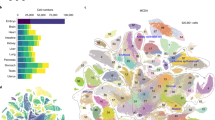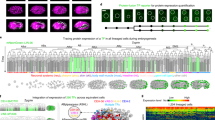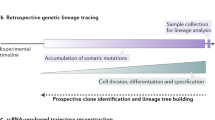Abstract
Fate mapping was once the province of classical experimental embryologists. Now a battery of new and sophisticated methods can be used to trace where cells go and what they do in embryos. Here we use examples from gastrulating fish and amphibian embryos and from the chick limb bud and central nervous system to show how this information has contributed to our understanding of developmental processes. This knowledge will become increasingly important in interpreting the complex patterns of gene expression that are being discovered during development, as well as in understanding the effects of genetic manipulations and in directing experimental interventions.
This is a preview of subscription content, access via your institution
Access options
Subscribe to this journal
Receive 12 print issues and online access
$209.00 per year
only $17.42 per issue
Buy this article
- Purchase on Springer Link
- Instant access to full article PDF
Prices may be subject to local taxes which are calculated during checkout



Similar content being viewed by others
References
Vogt, W. Gestaltungsanalyse am Amphibienkeim mit örtlicher Vitalfärbung. Vortwort über Wege and Ziele. I. Teil: Methodik undWirkungsweise der örtlichen Vitalfärbung mit Agar als Farbträger. Wilhelm Roux Arch. Entwicklungsmech. Org. 106, 542–610 (1925).
Vogt, W. Gestaltungsanalyse am Amphibienkeim mit örtlicher Vitalfärbung. II. Teil: Gastrulation und Mesodermbildung bei Urodelen und Anuren. Wilhelm Roux Arch. Entwicklungsmech. Org. 120, 384–706 (1929)
Keller, R. E. Vital dye mapping of the gastrula and neurula of Xenopus laevis. I. Prospective areas and morphogenetic movements of the superficial layer. Dev. Biol. 42, 222–241 (1975).
Keller, R. E. Vital dye mapping of the gastrula and neurula of Xenopus laevis. I. Prospective areas and movements of the deep layer. Dev. Biol. 51, 118–137 (1976).
Smith, J. C. & Malacinski, G. M. The origin of the mesoderm in an anuran Xenopus laevis and a urodele Ambystoma mexicanum. Dev. Biol. 98, 250–254 (1983).
Saxen, L. & Toivonen, S. Primary Embryonic Induction (Logos, London, 1962).
Spemann, H. & Mangold, H. Uber Induktion von Embryonalanlagen durch implantation artfremder organisatoren. Wilhelm Roux Arch. Entwicklungsmech. Org. 100, 599–638 (1924).
Sasai, Y., Lu, B., Steinbeisser, H., De Robertis, E. M. Regulation of neural induction by the Chd and Bmp-4 antagonistic patterning signals in Xenopus. Nature 376, 333–336 (1995).
Wilson, P. A. & Hemmati-Brivaniou, A. Induction of epidermis and inhibition of neural cell fate. Nature 376, 331–333 (1995).
Saunders, J. W. Jr The proximo-distal sequence of the origin of the parts of the chick wing and the role of ectoderm. J. Exp. Zool. 108, 363–403 (1948).
Hampé, P. A. Contribution a l’étude du dévelopment et de la régulation des deficiences at des excédents dans la patte de l’embryon de poulet. Arch. D’anat. Microscop. Morphol. Exp. Suppl. 48, 347–479 (1959).
Stark, R. J. & Searls, R. L. A description of the chick wing bud development and a model of limb morphogenesis. Dev. Biol. 33, 138–153 (1973).
Bowen, J., Hinchliffe, J. R., Horder, T. J. & Reeve, A. M. F. The fate map of the chick forelimb-bud and its bearing on hypothesized developmental control mechanisms. Anat. Embryol. 179, 269–283 (1989).
Le Douarin, N. M. The Neural Crest (Cambridge Univ. Press, Cambridge, 1982).
Le Douarin, N. M. Cell recognition based on natural morphological nuclear markers. Med. Biol. 52, 281–319 (1974).
Selleck, M. A. J. & Bronner-Fraser, M. Origins of the avian neural crest: the role of the neural plate-epidermal interactions. Development 121, 525–538 (1995).
Vargesson, N. et al. Cell fate in the chick limb bud and relationship to gene expression. Development 124, 1909–1918 (1997).
Honig, M. G. & Hume, R. I. DiI and DiO: versatile fluorescent dyes for neural labelling and pathway tracing. Trends Neurosci. 12, 333–341 (1989).
Summerbell, D. A. Quantitative analysis of the effect of excision of the AER from the chick limb-bud. J. Embryol. Exp. Morphol. 32, 651–660 (1974).
Schwabe, J. W. R., Rodriguez-Esteban, C. & Izpisúa Belmonte, J. C. Limbs are moving; where are they going? Trends Genet. 14, 229–235 (1998).
Johnson, R. L. & Tabin, C.J. Molecular models for the vertebrate limb development. Cell 90, 979–990 (1997).
Izpisúa-Belmonte, J. C. & Dubole, D. Homeobox genes and pattern formation in the vertebrate limb. Dev. Biol. 152, 26–36 (1992).
Nelson, C. E. et al. Analysis of Hox gene expression in the chick limb bud. Development 122, 1449–1466 (1996).
Fromental-Ramain, C. et al. Hoxa13 and Hoxd13 play a crucial role in the patterning of the limb autopod. Development 122, 2997–3011 (1996)
Martin, G. R. The role of FGFs in the early development of vertebrate limbs. Genes Dev. 12, 1571–1586 (1998).
Sauders, J. W. Jr & Gasseling, M. T. in Epithelial–Mesenchymal Interactions (eds Fleischmaier, R. & Billingham, R. E.) 78–97 (Williams and Wilkins, Baltimore, 1968).
Riddle, R. D., Johnson, R. L., Laufer, E. & Tabin, C. Sonic hedgehog mediates the polarizing activity of the ZPA. Cell 75, 1401–1416 (1993).
Yang, Y. et al. Relationship between does, distance and time in Sonic Hedgehog-mediated regulation of anteroposterior polarity in the chick limb. Development 124, 4393–4404 (1997).
Lewis, J. in Vertebrate Limb and Somite Morphogenesis (eds Ede, D. A., Hinchcliffe, J. R. & Balls, M.) 215–228 (Cambridge Univ. Press, Cambridge, 1977).
Kimmel, C. B., Warga, R. & Kane, D. A. Cell cycles and clonal strings during formation of the zebrafish central nervous system. Development 120, 265–276 (1994).
Christ, B., Jacob, H. J. & Jacob, M. Experimental analysis of origin of the wing musculature in avian embryos. Anat. Embryol. 150, 171–186 (1977).
Chevallie, A. & Kieny, M. On the role of the connective tissue in the patterning of the chick limb musculature. Wilhelm Roux Arch. Dev. Biol. 191, 277–280 (1982).
Butler, J., Cosmos, E. & Cauwenberg, P. Positional signals: evidence for a possible role in muscle fibre-type patterning of the embryonic avian limb. Development 102, 763–772 (1988).
Garcia-Bellido, A., Ripoll, P. & Morata, G. Developmental compartmentalisation of the wing disk of Drosophila. Nature New. Biol. 245, 251–253 (1973).
Fraser, S., Keynes, R. & Lumsden, A. Segmentation in the chick embryo hindbrain is defined by cell lineage restriction. Nature 344, 431–435 (1990).
Wingate, R. J. T. & Lumsden, A. Persistence of rhombomeric organisation in the postsegmental hindbrain. Development 122, 2143–2152 (1996).
Altabef, M., Clarke, J. D. W. & Tickle, C. Dorso-ventral ectodermal compartments and origin of apical ectodermal ridge in developing chick limb. Development 124, 4547–4556 (1997).
Loomis, C. A. et al. The mouse Engrailed-1 gene and ventral limb patterning. Nature 382, 360–363 (1996).
Sulston, J. E., Schierenberg, E., White, J. G. & Thomson, J. N. The embryonic cell lineage of the nematode Caenorhabditis elegans. Dev. Biol. 100, 64–119 (1983).
Dale, L. & Slack, J. M. W. Fate map for the 32-cell stage of Xenopus laevis. Development 99, 527–551 (1987).
Moody, S. A. Fates of the blastomeres of the 16-cell stage Xenopus embryos. Dev. Biol. 122, 300–319 (1987).
Moody, S. A. Fates of the blastomeres of the 32-cell stage Xenopus embryos. Dev. Biol. 122, 300–319 (1987).
Sanes, J. R., Rubenstein, J. L. R. & Nicolas, J.-F. Use of a recombinant retrovirus to study post-implantation cell lineage in mouse embryos. EMBO J. 5, 3133–3142 (1986).
Price, J., Turner, D. & Cepko, C. L. Lineage analysis in the vertebrate nervous system by retrovirus-mediated gene transfer. Proc. Natl Acad. Sci. USA 84, 156–160 (1987).
Fields-Berry, S. C., Halliday, A. L. & Cepko, C. L. A recombinant retrovirus encoding alkaline phosphatase confirms clonal boundary assignment in lineage analysis of murine retina. Proc. Natl Acad. Sci. USA 89, 693–697 (1992).
Luskin, M. B., Parnavelas, J. G. & Barfield, J. A. Neurons, astrocytes and oligodendrocytes of the rat cerebral cortex originate from separate progenitor cells: an ultrastructural analysis of clonally related cells. J. Neurosci. 13, 1730–1750 (1993).
Grove, E. A. et al. Multiple restricted lineages in the embryonic rat cerebral cortex. Development 117, 553–561 (1993).
Parnavelas, J. G. Glial cell lineages in the rat cerebral cortex. Exp. Neurol. 156, 418–429 (1999).
Lavdas, A. A., Mione, M. C. & Parnavelas, J. G. Neuronal clones in the ceebral cortex show morphological and neurotransmitter heterogeneity during development. Cereb. Cortex 6, 490–497 (1996).
Walsh, C. & Cepko, C. L. Widespread dispersion of neuronal clones across functional regions of the cerebral cortex. Science 255, 434–440 (1992).
Golden, J. A., Fields-Berry, S. C. & Cepko, C. L. Construction and characterisation of a highly complex retroviral library for lineage analysis. Proc. Natl Acad. Sci. USA 92, 5704–5708 (1995).
Mione, M. C., Cavanagh, J. F. R., Harris, B. & Parnavelas, J. G. Cell fate specification and symmetrical/asymmetrical divisions in the developing cerebral cortex. J. Neurosci. 17, 2018–2029 (1997).
Anderson, S. A., Eisenstat, D. D., Shi, L. & Rubenstein, J. L. R. Interneuron migration from basal forebrain to neocortex: dependence on Dlx genes. Science 278, 474–476 (1997).
Miller, R. H. Oligodendrocyte origins. Trends Neurosci. 19, 92–96 (1996).
Leber, S. M., Breedlove, S. M. & Sanes, J. R. Lineage, arrangement, and death of clonally related motoneurons in chick spinal cord. J. Neurosci. 10, 2451–2462 (1990).
Erskine, L., Patel, K. & Clarke, J. D. W. Progenitor dispersal and the origin of early neuronal phenotypes in the chick embryo spinal cord. Dev. Biol. 199, 26–41 (1998).
Tanabe, Y. & Jessell, T. M. Diversity and pattern in the developing spinal cord. Science 274, 1115–1123 (1996).
Lumsden, A., Clarke, J. D. W., Keynes, R. & Fraser, S. E. Early phenotypic choices by neuronal precursors, revealed by clonal analysis of the chick embryo hindbrain. Development 120, 1581–1589 (1994).
Clarke, J. D. W., Erskine, L. & Lumsden, A. Differential progenitor dispersal and the spatial origin of early neurons can explain the predominance of single-phenotype clones in the chick hindbrain. Dev. Dyn. 212, 14–26 (1998).
Sauer, B. Inducible gene targetting in mice using the Cre/lox system. Methods 14, 381–392 (1998).
Nicolas, J. F., Mathis, L., Bonnerot, C. & Saurin, W. Evidence in the mouse for self-renewing stem cells in the formation of a segmented longitudinal structure, the myotome. Development 122, 2933–2946 (1996).
Mathis, L., Bonnerot, C. Puelles, L. & Nicolas, J. F. Retrospective clonal analysis of the cerebellum using genetic laacZ/lacZ mouse mosaics. Development 124, 4089–4104 (1997).
Fishell, G. Striatal precursors adopt cortical identities in response to local cues. Development 121, 803–812 (1995).
Goldstein, A. M. & Fishman, M. C. Notochord regulates cardiac lineage in zebrafish embryos. Dev. Biol. 201, 247–252 (1998).
Cambridge, S. B., Davis, R. L. & Minden, J. S. Drosophila mitotic domain boundaries as cell fate boundaries. Science 277, 825–828 (1997).
Zernicka-Goetz, M. et al. An indelible lineage marker for Xenopus using a mutated fluorescent protein. Development 122, 3719–3724 (1996).
Jacobs, R. E. & Fraser, S. E. Magnetic resonance microscopy of embryonic cell lineages and movements. Science 263, 681–684 (1994).
Huber, M. M. et al. Fluorescently detectable magnetic resonance agents. Bioconjug. Chem. 9, 242–249 (1998).
Author information
Authors and Affiliations
Corresponding author
Rights and permissions
About this article
Cite this article
Clarke, J., Tickle, C. Fate maps old and new. Nat Cell Biol 1, E103–E109 (1999). https://doi.org/10.1038/12105
Issue Date:
DOI: https://doi.org/10.1038/12105
This article is cited by
-
Building a lineage from single cells: genetic techniques for cell lineage tracking
Nature Reviews Genetics (2017)
-
Origin of new cells in the adult kidney: results from genetic labeling techniques
Kidney International (2011)
-
In vitro whole-organ imaging: 4D quantification of growing mouse limb buds
Nature Methods (2008)
-
A stop‐EGFP transgenic mouse to detect clonal cell lineages generated by mutation
EMBO reports (2004)
-
The chicken as a model for large-scale analysis of vertebrate gene function
Nature Reviews Genetics (2003)



